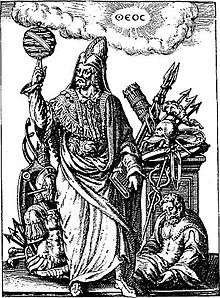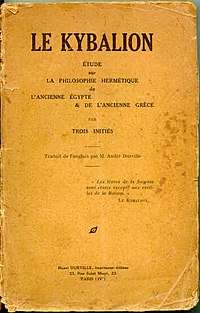The Kybalion
The Kybalion: Hermetic Philosophy, originally published in 1908 under the pseudonym of "the Three Initiates", is a book claiming to be the essence of the teachings of Hermes Trismegistus.
| Part of a series on |
| Hermeticism |
|---|
 |
| Mythology |
| Hermetica |
|
"Three Parts of the Wisdom of the Whole Universe" |
| Movements |
|
| Orders |
|
| Topics |
|
| People |
|
General description

The Kybalion was first published in 1908 by the Yogi Publication Society in Chicago, Illinois and has been in the public domain since 1977. Purportedly based upon ancient Hermeticism, its philosophies became founding pillars within the New Thought movement of the early 1910s. The book early on makes the claim that it makes its appearance in one's life when the time is appropriate and includes axioms and insights similar to those found in the Book of Proverbs.
Authorship
The "Three Initiates" who authored The Kybalion chose to remain anonymous. As a result, a great deal of speculation has been made about who actually wrote the book. The most common proposal is that The Kybalion was authored by William Walker Atkinson, either alone or with others, such as Paul Foster Case and Elias Gewurz.
Atkinson was known to use many pseudonyms, and to self-publish his works. Also suggestive is that among his earliest published pseudonymous and anonymous works may have been a series entitled The Arcane Teachings (first published prior to 1909 and the second edition in 1909), which bears many superficial similarities to The Kybalion. While the latter explores seven "Hermetic Principles", The Arcane Teachings examines seven "Arcane Laws"; The Kybalion claims to be an elucidation of an ancient, unpublished Hermetic text of the same name, and The Arcane Teachings claims to reveal the wisdom of an ancient, unpublished scroll of occult aphorisms. Both books describe three "Great Planes" of reality which are further subdivided into seven lesser planes. Both also describe three of the lesser planes as "astral black keys" analogous to the black keys on a piano, and inhabited by elemental spirits. And both books describe the process of "Mental Alchemy" in great detail, and in near-complete agreement with each other. There are other similarities, and some argue that The Arcane Teachings might have been Atkinson's "first draft" of material which later became The Kybalion. Atkinson also attempted to describe the workings of the universe in terms of a set of laws in his last manuscript The Seven Cosmic Laws, written in 1931 and published posthumously in 2011.
A common theory is that Atkinson co-wrote the book with Paul Foster Case and Michael Whitty. This theory is often held by members of Builders of the Adytum (B.O.T.A.), the Mystery School later founded by Case, though it doesn't publicly make this claim. This story appears to have originated with a B.O.T.A. splinter group, the Fraternity of the Hidden Light.[1]
Along these lines, much has been made about Paul Foster Case's being a Freemason, and that The Kybalion's publisher, the Yogi Publication Society, gave its address as "Masonic Temple, Chicago IL" on the book's frontispiece. However, Chicago's "Masonic Temple" was also the city's first skyscraper, housing dozens of stores and small businesses without any Masonic affiliations, and named for the Masonic Lodge which financed much of its construction and met in its top few floors.[2]
Other names speculatively mentioned as co-authors of The Kybalion include Harriet Case (Paul Foster Case's wife at the time), Mabel Collins (a prominent Theosophical writer), Claude Bragdon (an architect, Theosophist, and writer on "mystic geometry"), and Claude Alexander (a well-known stage magician, mentalist, proponent of crystal gazing, and New Thought author). Ann Davies, who succeeded Case as head of the B.O.T.A., is often mentioned as a possible Kybalion contributor, but she was born in 1912—four years after the book's first publication.
The introduction for a 2011 edition of The Kybalion published by Tarcher/Penguin presents an argument that William Walker Atkinson was the sole author of the work, including evidence such as the 1912 edition of Who's Who in America, which attributes Atkinson as the author, and a 1917 French language edition of The Kybalion in which the translator's introduction attributes the work to "the American psychic master W.W. Atkinson."[3]
The seven Principles
The book devotes a chapter to each of its seven "Principles", or axioms:
Principle of Mentalism
The Principle of Mentalism embodies the idea that "All is Mind." Everything that happens has to be a result of a mental state which precedes it. For anything to exist, thoughts had to form first, which then form physical reality or manifestation. "Your thoughts are seeds, plant positive seeds in your mind garden."
Principle of Correspondence
The Principle of Correspondence expresses the idea that there is always a correspondence between the laws of phenomena of the various "planes" of being and life.[4] As above, so below; as below, so above. This principle states that there is a harmony which can be made, agreement and correspondence between these planes, delineated as:
- The Great Physical Plane
- The Great Mental Plane
- The Great Spiritual Plane
Principle of Vibration
This expounds the idea that motion is manifest in everything in the Universe, that nothing rests, and everything moves, vibrates and circles.[5] This principle explains that the distinction between manifestations of Matter, Energy, Mind, and even Spirit, are the result of only different "vibrations".[6] The higher a person is on the scale, the higher the rate of vibration will be. Here, The All is said to be at an infinite level of vibration, almost to the point of being at rest. There are said to be millions upon millions of varying degrees between the highest level, The All, and the objects of the lowest vibration.[7]
Mental Transmutation is described as the practical application of this principle. To change one's mental state is to change vibration. One may do this by an effort of Will, by means of deliberately "fixing the attention" upon a more desirable state.[8]
Principle of Polarity
The Principle of Polarity embodies the idea that everything is dual, everything has two poles, and everything has its opposite.[9] All manifested things have two sides, two aspects, or two poles.[10] Everything "is" and "isn't" at the same time, all truths are but half truths and every truth is half false, there are two sides to everything, opposites are identical in nature yet different in degree, extremes meet, and all paradoxes may be reconciled.[11]
Principle of Rhythm
The Principle of Rhythm expresses the idea that in everything there is manifested a measured motion, a to and from, a flow and inflow, a swing backward and forward, a pendulum-like movement.[12] There is rhythm between every pair of opposites, or poles, and is closely related to the Principle of Polarity.[13] It can be seen that this Principle enables transition from one pole to the other, and not necessarily poles of extreme opposites.
Principle of Cause and Effect
It explains that there is a cause for every effect, and an effect for every cause.[14] It also states that there is no such thing as chance, that chance is merely a term indicating extant causes not recognized or perceived.[15] The Principle is clarified in the chapter Causation.
Principle of Gender
The Principle of Gender embodies the idea that gender is manifested in everything.[16] The authors state that this does not relate explicitly to the commonly understood notion of sex, but rather "... to beget; to procreate, to generate, to create, or to produce..." in general.[17] Gender manifests itself on all planes as the Feminine and Masculine principles.
Mental Gender is described as a Hermetic concept which relates to the feminine and masculine principles. It does not refer to someone's physical sex, nor does it suggest that someone of a certain sex necessarily has a matching mental gender. Ideally, one wants to have a balanced mental gender.[18]
The concept put forth in The Kybalion states that gender exists on all planes of existence (Physical, Mental and Spiritual), and represents different aspects on different planes. Everything and everyone contains these two elements or principles.[19]
The Feminine principle is always in the direction of receiving impressions, and has a much more varied field of operation than the Masculine. The Feminine conducts the work of generating new thoughts, concepts and ideas, including the work of the imagination.[20]
The Masculine principle is always in the direction of giving out or expressing, and contents itself with the "Will" in its varied phases.[21]
It is said that there must be a balance in these two forces. Without the Feminine, the Masculine is apt to act without restraint, order, or reason, resulting in chaos. The Feminine alone, on the other hand, is apt to constantly reflect and fail to actually do anything, resulting in stagnation. With both the Masculine and Feminine working in conjunction, there is thoughtful action that breeds success, which points out that both the Feminine and the Masculine fulfill each other.[22]
Influences
The works of the English philosopher Herbert Spencer are referred to approvingly in The Kybalion as showing an understanding of hermetic principles; and Spencer himself is eulogised as a reincarnation of the 5th century BCE Greek philosopher Heraclitus; who is in turn described as being a reincarnation of a still more ancient, Egyptian philosopher. No other writers are similarly referenced or endorsed within the text.
Languages
The Builders of the Adytum consider The Kybalion an essential foundation of their beliefs, and have translated the original text into Spanish, German and French,[23] the last was completed by André Durville.[24] The Kybalion itself claims to have influenced all major religions and philosophies ancient and modern alike.[25]
See also
- Emerald Tablet (of Hermes Trismegistus)
- Gnosticism
- Hermetica
- Magic (paranormal)
- Occultism
Notes
- Clark, P. (2013).Paul Foster Case. His Life and Works. Covina CA: Fraternity of the Hidden Light, 23. See also "Archived copy" (PDF). Archived from the original (PDF) on 2003-04-23. Retrieved 2007-01-16.CS1 maint: archived copy as title (link) for more information.
- Emporis GmbH. "Masonic Temple, Chicago - 102685 - EMPORIS". emporis.com. Retrieved 5 June 2015.
- "Amazon.com: The Kybalion: The Definitive Edition (9781585428748): William Walker Atkinson, Three Initiates, Philip Deslippe: Books". amazon.com. Retrieved 5 June 2015.
- Kybalion page 28
- Kybalion page 137
- Kybalion page 30
- Kybalion page 31
- Kybalion page 214
- Kybalion page 32
- Kybalion page 149
- Kybalion pages 149-150
- Kybalion page 36
- Kybalion page 159
- Kybalion page 38
- Kybalion page 171
- Kybalion pages 39-40
- Kybalion page 183
- Three Initiates pp. 193-211
- (Three Initiates page 40)
- (Three Initiates p. 203)
- (Three Initiates page 203)
- (Three Initiates pp. 203-4)
- "B.O.T.A. Builders of the Adytum". www.bota.org. Retrieved 2017-01-08.
- initiés, Trois; Durville, André (1997-03-01). Le Kybalion : Etude sur la philosophie hermétique de l'ancienne Egypte et de l'ancienne Grèce. Paris: Librairie du Magnétisme. ISBN 9782913695009.
- The Kybalion, p. 12, Biblio Bazaar LLC, 2008 ISBN 978-0-554-35434-7